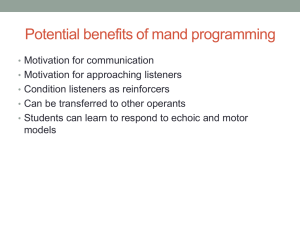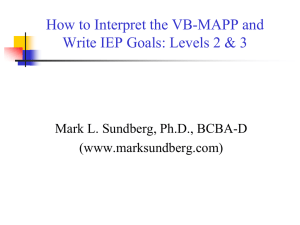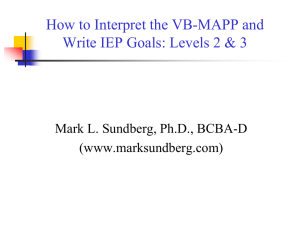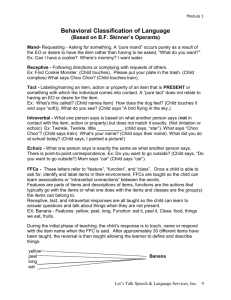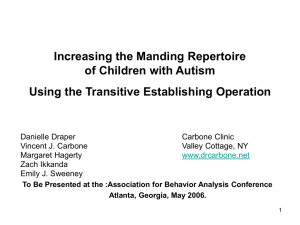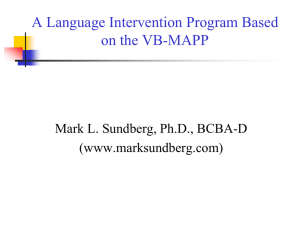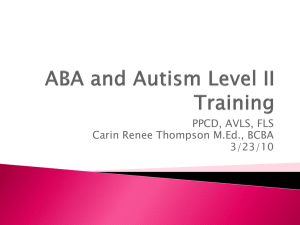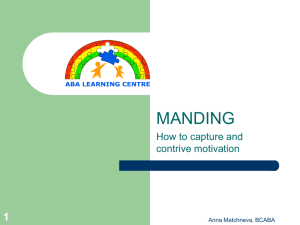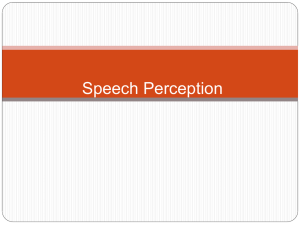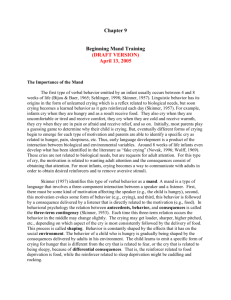Introduction to Verbal Behavior
advertisement
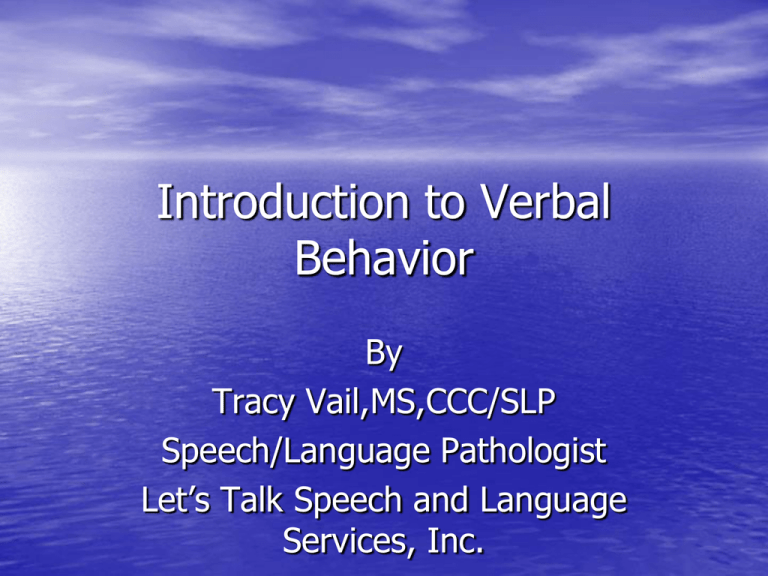
Introduction to Verbal Behavior By Tracy Vail,MS,CCC/SLP Speech/Language Pathologist Let’s Talk Speech and Language Services, Inc. Contingencies Antecedent/Stimulus Response (Function Alt.) Evocative Consequence Function Altering Reinforcement Soc. Med + Soc. Med – Auto + R (s-delta) CSS Auto – Extinction MO SD Punishment Positive Punishment Negative Punishment Self-Stimulatory Behavior Build Motivation (MO) • • • • • • • • • • • Establish Reinforcers- everyone wants something! Start with non-verbal connection then add verbal How does the child respond to the environment? Be playful- play as children play Build anticipation Do the unexpected Create routines Gradually change the routines Stay connected to find reinforcers Be animated Pair yourself and talking with reinforcement BE the Reinforcer! DO • Teach errorlessly • Fade in demands • Teach to Fluency • Prompt Quickly • Fade prompts Don’t • follow negative behavior with reinforcement • Remove a child from a reinforcing activity to begin teaching • Give directions to do things you can’t prompt • Make sure all questions have answers • Give directions without getting compliance • Find numerous reinforcers • Kill reinforcers by placing too many demands • Correct errors • Have fun! Pair Sounds/Talking with Fun! Pairing Sounds with Fun! Imitate All Sounds Produced Reinforce all vocal attempts Pairing with favorite activities Transfer Procedures/Prompting • Teach a new behavior by starting with a behavior that you know the child can already do. • The child is more likely to repeat the same behavior under a different condition • Once the behavior is taught under the new condition, gradually fade the prompt • New learning is build on old learning • The learning remains “errorless” Teaching Procedure for Transfers • Transfer trial- Use the mastered skill to evoke the desired behavior then present the new SD to get the same behavior. • Disractor trial(s)- Present a mastered task or two • Independent trial- Re-present the new SD to evoke the behavior and reinforce correct response heavily Correction Procedure • Use whenever the child responds incorrectly • Give the SD + the response • Wait for the echoic • Repeat the SD • Wait for the response • Run a distractor trial (something the child can do easily) • Repeat the SD Verbal Operants What purpose does the communication serve to the speaker and listener? • Mands- “I talk, I get” • Tacts- I can label things in the environment • • • under a variety of conditions Receptives- I can follow directions, do what others tell me to do Imitation/Echoics- I can do/say what others do/say Intraverbal- What I say is dependent upon what others say but is not the same Manding • • • • • • • • • • The basis of all other verbal behavior Teach by transferring from echoics or “fill-ins” Giving up the things we want With and without items present With and without someone asking “What do you want? Teach a variety of sentence forms Manding from peers Expand sentence length and teach concepts through mands Teach manding for information Manding for attention Choosing Response Forms • If child is non-vocal, must use an • • • • • • • alternative/augmentative system Augmentative communication encourages rather than discourages vocal productions Experiment to determine how the child responds to various forms Picture/object exchange Signs Communication Boards Vocal Voice output devices Manding with PECS Manding with Signs Be sure not to fade signs too quickly Watch for Sign/Vocal Inconsistencies Shaping Vocals through Mands Gradually Build Syllables NET Manding/Mands for Info Begin Teaching in “scripted” play Generalize in less structured format Teaching Concepts through Mands Imitation • Teach through physical prompting or anticipating actions • Important for independent learning and play • Teach child to do multiple actions in response to “Do this” • Gradually increase difficulty and complexity Mix NVI’s with other Operants Echoics- Vocal Imitation • Teach by transferring from mand, motor imitation, songs, “sound play” and pairing with reinforcement • Use visual and/or physical prompting as necessary • Gradually increase length and complexity • Shape through the mand Teaching Isolated Sounds Receptive • Teach by transferring from imitation or with physical prompts • Teach the child to respond to a variety of SDs (touch, find, show, where’s the etc.) • Start with items the child can mand for as well as simple instructions (i.e. come, sit, clap) • Gradually increase complexity. Closely monitor conditional discriminations Add receptives to reinforcing activities Tacts • Teach by transferring from receptive (if child tacts), mand, fill-in, intraverbal or echoic. • Labeling objects, actions, parts, features, classes, functions • Be sure to vary SD’s • Verbal modules- teach the child to discriminate between question forms • Build them up and break them down Receptive Objects Fill-in to Tact Transfers Intraverbal • Talking about things not present • Transfer from fill-in, tact, or echoic • Create “intraverbal links” • Begin with songs, rhymes, stories and daily activities • Gradually increase complexity • Teach reversal fill-ins early • Mands for information + intraverbals = conversation Fill-ins with Books Fill-ins with Songs Intensive Teaching • Use to practice skills taught in the natural environment • Make sure instructors have mastered transfer and correction procedures to fluency • Mix and vary to make sure the child is responding to the correct SD Intraverbal FFC’s/Categories in Intensive Teaching Use Available Reinforcers Dealing with Negative Behaviors • New Behavior (talking) won’t be used if the old behavior • • • • • • (hitting) still works Must determine function of the behavior before determining how to respond Look at what happened right before and right after the behavior Put time between negative behavior and prompting appropriate communication The child never gets anything for negative behavior Don’t live your life trying to avoid negative behaviors Get a functional analysis by a behavior analyst if problems persist Suggested Readings • Educate Towards Recovery by Robert Schramm • The Assessment of Basic Language and Learning • • Skills (The ABLLS) by Partington and Sundberg The Mariposa School Training Manual by Tracy Vail Handouts available at letstalksls.com (Answers Database) Thanks for who you are for children!


